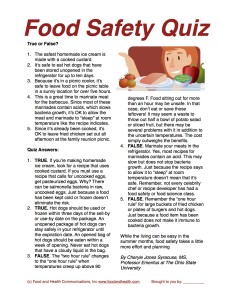Summer just seems to scream “let’s eat outdoors!” It’s important to remember that these opportunities for picnics, patio dining, and special summer foods also bring different problems and situations into the food safety picture. Here’s a quick quiz that can be used as a refresher for food safety in the summer.
 Are the following questions true or false?
Are the following questions true or false?
- The safest homemade ice cream is made with a cooked custard.
- It’s safe to eat hot dogs that have been stored unopened in the refrigerator for up to ten days.
- Because it’s in a picnic cooler, it’s safe to leave food on the picnic table in a sunny location for over five hours.
- This is a great time to marinate meat for the barbeque. Since most of these marinades contain acids, which slows bacteria growth, it’s OK to allow the meat and marinade to “steep” at room temperature like the recipe indicates.
- Since it’s already been cooked, it’s OK to leave fried chicken set out all afternoon at the family reunion picnic.
Are you ready for the answers? Here they are!
1. TRUE. If you’re making homemade ice cream, look for a recipe that uses cooked custard. If you must use a recipe that calls for uncooked eggs, get pasteurized eggs or egg whites. Why? Well, there can be salmonella bacteria in raw, uncooked eggs and just because a food has been kept cold or frozen doesn’t eliminate the risk.
2. TRUE. Check the expiration date on those hot dogs. Hot dogs should be used or frozen within three days of the sell-by or use-by date on the package. An unopened package of hot dogs can stay safely in your refrigerator until the expiration date (or two weeks if there is no date). An opened bag of hot dogs should be eaten within a week of opening. Never eat hot dogs that have a cloudy liquid in the bag.
3. FALSE. The “two hour rule” changes to the “one hour rule” when temperatures creep up above 90 degrees F. This means that you should not allow food to sit out at room temperature for longer than one hour. Hot temperatures are just right for allowing the bacteria in food to multiply to numbers that could make people sick. When everyone is done eating, get that food quickly into coolers or a refrigerator. When storing food in coolers, use lots of ice. It’s hard to keep the temperature of food in coolers below 40 degrees. Five hours may be too long to ensure that food is safe. In that case, don’t eat or save those leftovers! It may seem a waste to throw out half a bowl of potato salad or sliced fruit, but there may be several problems with it in addition to the uncertain temperatures (i.e. bugs, lots of people around — did they double dip?). Unless you are absolutely sure of the safety of the food, pitch any leftovers.
4. FALSE. Marinate your meats in the refrigerator. Yes, most recipes for marinades contain an acid. This may slow but does not stop bacteria growth. Just because the recipe says to allow it to “steep” at room temperature doesn’t mean that it’s safe. Remember, not every celebrity chef or recipe developer has had a food safety or food science class.
5. FALSE. Remember that “one hour rule” for large buckets of fried chicken or plates of burgers and hot dogs. Just because a food item has been cooked does not make it immune to bacteria growth.
While the living can be easy in the summer months, food safety takes a little more effort and planning.
By Cheryle Jones Syracuse, MS, Professor Emeritus at The Ohio State University
There are lots of other amazing summer resources in the Nutrition Education Store! We’re here to help you look your very best, right now!




